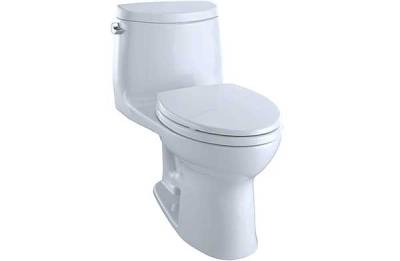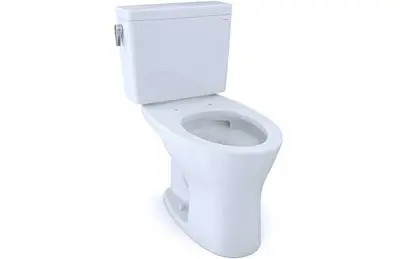Is it that time of the year you are planning to replace your old toilet or give your bathroom a total revamp?
Are you currently sitting on the fence and haven’t decided on the type of porcelain throne to adorn your bathroom?
This guide sheds light on two of the common toilet variants you will find on the market today.
Manufacturers today generally produce two main types of toilets:
- One-piece (single), or
- Two-piece toilet
These two toilet types have been locked in decades-old debates about which is better.
In reality, these toilets function the same way and, on many occasions, flaunt the same features and flushing mechanisms.
The installation of both variants doesn’t differ. Both toilet models come with top-level performance and modern designs.
However, despite the similarities between these two commodes, several differences distinguish them.
The two-piece toilet is one of the oldest toilet models ever built. Nonetheless, the primary reason the one-piece toilet has a more prominent following is due to its size and some other not-so-significant features.
Looks are everything to a lot of buyers out there. It is why the one-piece toilet always comes out top when placed side by side with the two-piece toilet. We’ll dig beyond the looks to ascertain for sure if the one-piece toilet is better than the two-piece toilet.
The One-piece Toilet

This type of toilet is one of the newest toilets design available on the market.
It has its tank and bowl fused to form a single unit. The one-piece toilet is usually smaller and perfect for smaller bathrooms.
Because of its design, the one-piece toilet is usually expensive to produce, and hence costs more than the two-piece toilet variant.
Pros
- Easy to clean and maintain
- Smaller in size and a good option for smaller bathrooms
- It is durable as it comes with no joining parts
- Great aesthetic
- Easy to install
- Offers a mounting option
Cons
- Pricey
- Difficult to move
- Limited rough-in options
The Two-Piece Toilet

The two-piece toilet comes with its tank built separately from the bowl.
It has been in existence for a very long time and remains a lot cheaper than the one-piece toilet. The fact that the two-piece toilet is less expensive makes it a homeowner’s favorite in terms of demand.
Furthermore, it is much easier to install compared to the slightly heavier one-piece toilet.
If you are looking for a toilet unit you can install without the aid of a plumber, the two-piece toilet is the way to go.
Pros
- It is easy to install as the tank and bowl are separate from each other
- The price is affordable
- It is easy to ship
- Offers many options for rough-in, style and height
- Tank or bowl can be replaced separately
Cons
- Difficult to clean
- Grime, bacteria, and filth finds it easy to hide where the tank and bowl joins together
- Susceptible to leakages
Differences and Similarities of the One-piece Toilet and the Two-piece Toilet
They may perform the same function if you consider the grand scheme of things, but these units are quite different.
Let’s see some similarities and differences below.
The Toilet Size and Construction

The striking difference between these two toilet types is their size.
The one-piece toilet is customarily smaller than the two-piece toilet.
The former also has its tank and bowl fused or integrated to form a single compact unit.
On the other hand, the two-piece toilet has a separate tank built away from the toilet bowl.
It explains why people with ample bathroom space are likely to prefer the two-piece toilet.
Adults fancy this toilet because of its comfortable height above the ground.
The one-piece toilet is generally the toilet of choice for smaller bathrooms. It is perfect for children and people with disabilities as it is a bit lower to the ground.
Installation
If you intend to DIY, the one-piece toilet is simpler to install when placed in the right position. The downside is its weight considering that moving such hardware to its final position will require extra hands.
The separated components of the two-piece toilet make moving the pieces much more manageable.
If you correctly follow the instructions, you can install this type of toilet without help. Note, nonetheless, that the challenging step in the process involves mounting the fragile porcelain tank onto the bowl.
You’d also need to be careful not to overtighten the bolts to avoid cracks in the bowl and tank.
Whatever toilet type you buy, it is advisable to seek the services of a qualified plumber to help with its installation.
Durability
The lifespan of your toilet is solely dependent on the manufacturer and model.
The toilet’s longevity is never a matter of being a one-piece or two-piece toilet. However, because the one-piece toilet is a compact unit, it is less likely to leak from cracks.
Price
The two-piece toilet has been around for a long while. People are more familiar with it when compared to the one-piece toilet.
Furthermore, the cost of production is far less than that of the one-piece toilet, making it a cheaper option for most households.
The one-piece toilet is only lagging because it is less popular; however, it is easier to maintain and is projected to last longer, ultimately saving you money over time.
Maintenance
The one-piece toilet is easier to clean as it has no connections or hollows between the tank and bowl.
The likelihood of dirt and germs collecting in the nooks and crevices of the two-piece variant is higher.
Hence, to properly clean the two-piece toilet warrants disconnecting the tank and bowl.
In terms of cleaning and maintenance, the one-piece toilet wins hands down.
Performance

When it comes to performance, none of these toilets beats the other.
Depending on your toilet’s manufacturer, the flushing power and internal mechanics are practically the same.
The one-piece and the two-piece toilets can be ADA-compliant, come with WaterSense certification, and more features depending on the manufacturer and its compliance to government regulations.
What to Consider Before Buying a Toilet Unit
Whether you are rooting for the one-piece or two-piece toilet variant, there are factors to consider before buying one.
A unit with a big price tag is not always the best – in the housing industry, price is not everything.
The key recommendation: pick a toilet unit that conserves water and produces sufficient power to clean the bowl in a single flush at all times.
You’ll find different types of flushing mechanisms in both toilet types.
Flushing mechanisms include a double cyclone flush system, dual flush system, gravity flush system, tank-fill valve flush system, siphon flush mechanism, and pressure-assisted flush system.
Your toilet of choice should be convenient for the household and guaranteed to last for at least a decade.
Check what your home needs are and go for the toilet that best fits those needs.
Since it is a fact that toilets flush away about 30 percent of all household water in U.S. homes, the best and most efficient toilets must be easy to clean, WaterSense-certified, and ADA-compliant.
In any case, modern toilets are expected to use a maximum of 1.6 gallons of water per flush. That number is reduced to 1.28 gallons for toilets sold in California.
Crucially too, the toilet should perfectly fit your bathroom space and add a sparkle to its decor.
You’d want to limit your buying choices by making sure your toilet of choice matches the current toilet’s “rough-in” measurement.
Pricing is another thing!
Usually, the one-piece toilets are costlier when compared to their two-piece counterparts. Ensure to use our buying guides to pick one that falls within your budget.
Frequently Asked Questions (FAQs)
Q. Is the one-piece toilet any better than a two-piece toilet?
A. There are a few instances where the one-piece toilet excels over the two-piece toilet. These factors include minimizing space and ease of cleaning. However, performance-wise, both toilets are the same, depending on their flushing mechanisms.
Q. Can a one-piece toilet replace a two-piece toilet in my bathroom?
A. If you have a two-piece toilet unit and feel like updating the appearance of your bathroom with a new toilet, you can do so with a one-piece toilet.
All that is required is that you stick to the rough-in distance and the correct measurement. A quick glance at one piece toilet review.
Q. Should I Replace a leaking two-piece toilet?
A. Two-piece toilets are prone to leaks. However, one doesn’t need to press the panic button whenever there is a leak.
Leaks happen as a result of broken or cracked ceramics or worn-out gaskets. You’d want to be sure of the real cause of the leaks. Consult a plumber for a better diagnostic.
Nevertheless, consider replacing the unit if the porcelain/ceramic is damaged.
Q. Should I replace a broken/cracked bowl two-piece toilet?
A. Not necessarily. One of the advantages of the two-piece toilet is the fact that the bowl or tank can be replaced separately. However, if you own a one-piece toilet with a broken bowl, replacing the whole unit is best.
Final Words
The two-piece toilets are the cheapest and most common types of toilets. Homeowners prefer them because they’ve been around a long time.
On the other hand, the one-piece toilet is increasingly becoming popular due to its added advantages.
The one-piece toilets are the more expensive of the pair, but not without the benefits. It is expected that people will learn to accept the one-piece toilet more than the two-piece toilet as time goes on.
Your buying decision is dependent on your household needs. Rest easy, list out your preferences, and then hunt for a toilet type that meets your needs and suits your pocket.
Related Reviews:

